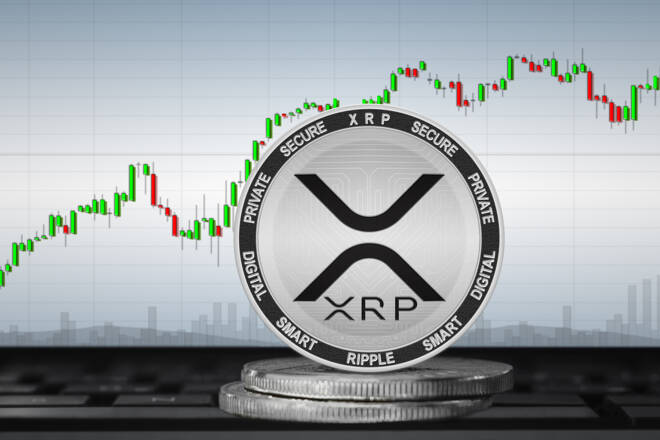Advertisement
Advertisement
XRP News Today: SEC Silence Fuels Ripple Settlement Speculation
By:
Key Points:
- XRP advanced by 0.53% on Friday, July 26, closing at $0.6034.
- SEC vs. crypto settlement hopes lingered after the July 25 closed meeting.
- Investors should consider SEC vs. crypto case-related news on Saturday, July 27.
XRP Retakes $0.60 but Lags The Broader Market
On Friday, July 26, XRP gained 0.53%. Partially reversing a 2.99% fall from Thursday, July 25, XRP closed the session at $0.6034. XRP trailed the broader market, which rallied 3.13% to a total crypto market cap of $2.369 trillion.
SEC Closed Meeting: Settlement or Appeal?
Hope turned to disappointment on Thursday, as the SEC remained silent about discussions from its closed meeting.
Speculation about Ripple attending the closed meeting to discuss settlement terms in the Ripple case fueled an XRP rally to a July 17 high of $0.6378.
Several reasons could explain the SEC’s silence on the Ripple case:
- Settlement terms needed further discussion.
- Ripple did not agree to Settle the case.
- Ripple did not attend the closed meeting.
For Ripple, a settlement would end SEC plans to appeal against any of Judge Torres’s rulings. In August 2023, the SEC attempted to appeal the Programmatic Sales of XRP ruling by filing a Motion for Interlocutory Appeal. However, Judge Torres rejected the Motion in October 2023, meaning the SEC must wait until the end of the Ripple case to appeal any court rulings.
In settlement talks, the SEC could target post-complaint activity, Ripple’s expansion plans for the US, and the Ripple stablecoin.
The Remedies-Related Briefs
In March 2024, the SEC filed its remedies-related opening brief, pushing for a $2 billion penalty and an injunction prohibiting XRP sales to institutional investors. The SEC argued that Ripple continued to violate US securities laws after the SEC’s December 2020 court filing (post-complaint).
In April 2024, Ripple filed its remedies-related opposition brief, arguing that a $10 million penalty would be appropriate. Ripple stated that post-complaint XRP sales did not breach US securities laws because XRP sales were:
- To accredited investors, exempt from US securities laws or
- Through On-Demand Liquidity (ODL) agreements that prevent profit or loss.
Ripple’s terms for its ODL agreements are significant. The SEC cannot argue that ODL agreements pass the Howey test if investors do not expect a profit. The Howey Test’s third prong is the expectation of profit through the effort of others.
In April 2024, the SEC filed its remedies-related reply brief, arguing that post-complaint activity looked similar to activity that led to the July 2023 court ruling. In the filing, the SEC also stated that Ripple’s stablecoin would be an unregistered security and in breach of US securities laws.
As background, Judge Torres ruled that Ripple violated US securities laws for selling unregistered XRP to institutional investors. Judge Torres also ruled that programmatic sales of XRP do not satisfy the third prong of the Howey Test.
Considering the court rulings and the arguments in the remedies-related filings, a settlement seems unlikely.
What Do the Experts Say?
Pro-crypto lawyer Bill Morgan commented on speculation about a settlement, saying,
“This is unlikely to happen but if it does it is a compromise not a big win. It means both parties give up something.”
Former SEC Lawyer Marc Fagel had this to say about closed meetings,
“I’ve tried to patiently explain to people what closed meetings are, how they work, and why a settlement (if it existed) likely wouldn’t even be calendared at one (as presumably the sole person here who used to attend them).”
Settlement Impact
If the SEC and Ripple settle, XRP could retake the $1.00 handle. On July 13, 2023, XRP reacted to the court filing, surging from $0.4696 to $0.9327.
However, the threat of an SEC appeal against the Programmatic Sales of XRP ruling could send XRP below $0.40.
Investors should remain alert as speculation about a settlement swirls. Stay updated with our latest news and analysis to manage exposures to XRP and the broader crypto market.
XRP Price Action
Daily Chart
XRP hovered comfortably above the 50-day and 200-day EMAs, affirming the bullish price signals.
An XRP break above the July 17 high of $0.6378 would support a move to the $0.6609 resistance level. A breakout from the $0.6609 resistance level could give the bulls a run at the $0.70 handle.
SEC vs. Ripple case-related news requires consideration.
Conversely, an XRP break below the $0.5739 supported level could signal a drop toward the 200-day EMA.
With a 14-day RSI reading of 61.56, XRP could climb to the July 17 high of $0.6378 before entering overbought territory.
About the Author
Bob Masonauthor
With over 28 years of experience in the financial industry, Bob has worked with various global rating agencies and multinational banks. Currently he is covering currencies, commodities, alternative asset classes and global equities, focusing mostly on European and Asian markets.
Advertisement
